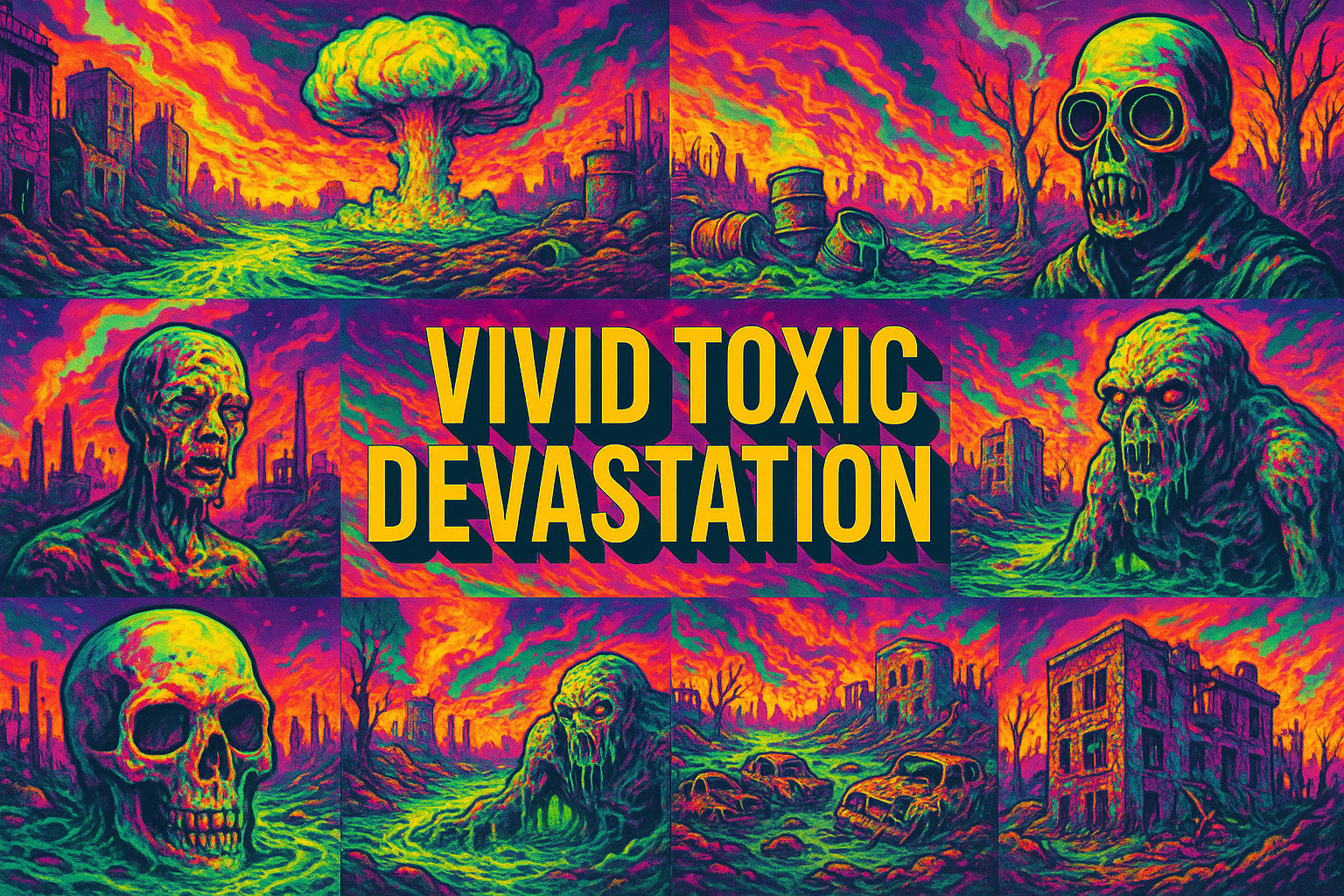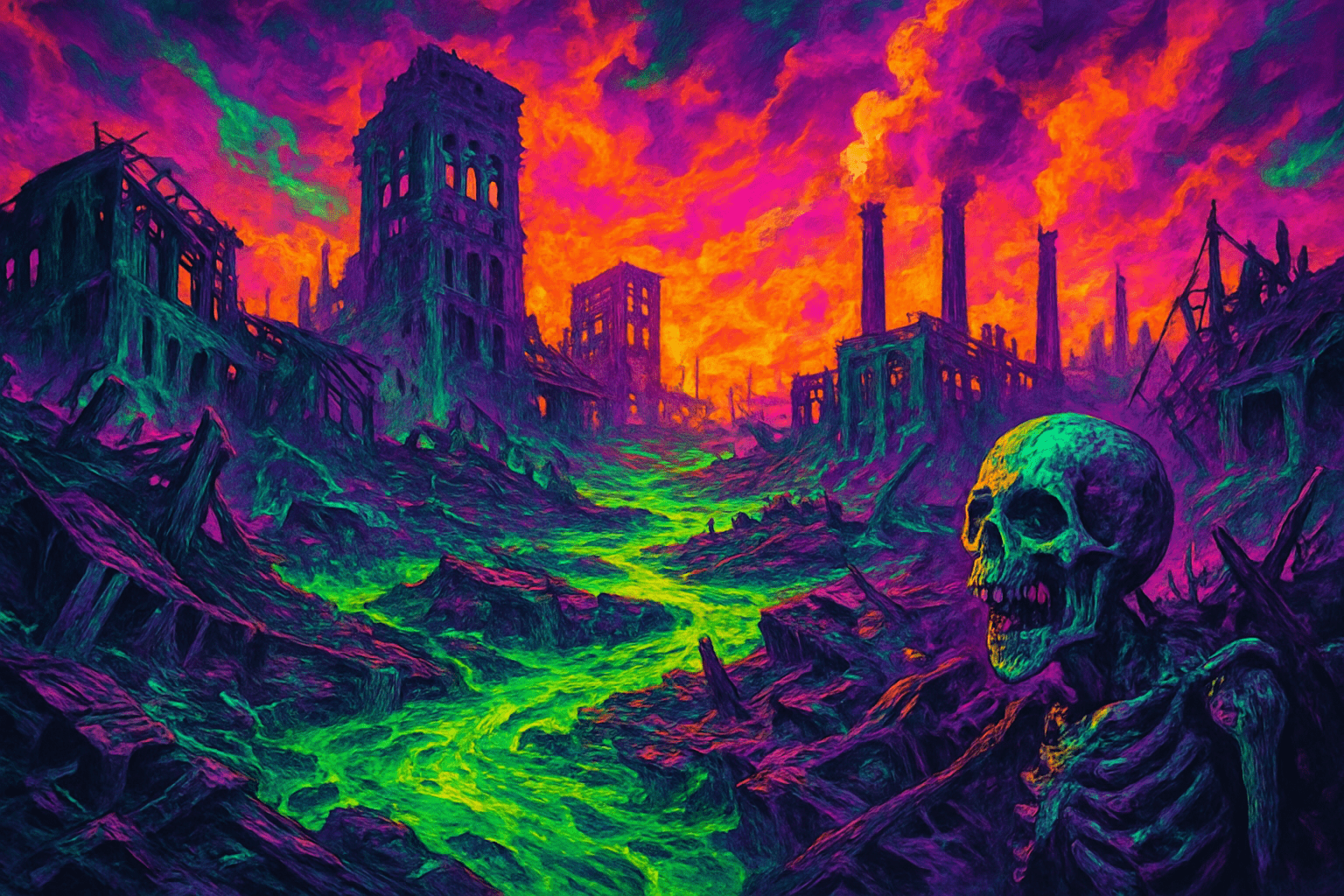
Vivid Toxic Devastation
The art style “Vivid Toxic Devastation” is characterized by its intense and striking visual elements. It typically features a vibrant color palette dominated by neon hues such as electric greens, bright pinks, and shocking yellows, creating a sense of artificiality and otherworldliness. The imagery often portrays scenes of urban decay and environmental destruction, where nature and technology collide in chaotic yet captivating ways. This style is marked by a high level of contrast, with sharp lines and bold shapes that give it a graphic, almost comic book-like quality. Textures may include corroded metals, cracked surfaces, and glitch-like digital distortions, enhancing the theme of degradation. Overall, the style evokes a sense of dystopian futurism, where beauty is found amidst the ruins of a toxic, yet vividly alive, world.
AOI thinking about Vivid Toxic Devastation [+_~]-/
Overview and Quickfacts
Vivid Toxic Devastation is an art style characterized by its bold use of vibrant colors combined with themes of environmental decay and urban dystopia. This style often juxtaposes bright, eye-catching hues with imagery that reflects pollution, industrial waste, and the consequences of human impact on nature. Artists working within this style aim to provoke thought and raise awareness about ecological issues by contrasting the beauty of vivid colors with the stark reality of environmental degradation. The resulting artwork is both visually striking and thematically poignant, encouraging viewers to reflect on the balance between human progress and environmental preservation.
Can understand it also, as:
The art style “Vivid Toxic Devastation” seems to be a creative and possibly niche term, especially within the context of AI-generated art. While there may not be direct synonyms for this specific style, we can speculate on related concepts and themes based on the name.
“Vivid” suggests bright, intense colors and striking visuals. Synonyms or related terms could include “vibrant,” “luminous,” “brilliant,” or “saturated.”
“Toxic” implies a sense of danger, pollution, or unnatural elements. Related terms might include “noxious,” “poisonous,” “corrosive,” or “contaminated.”
“Devastation” refers to destruction or ruin. Synonyms or related terms could be “destruction,” “ruin,” “wreckage,” or “catastrophe.”
Combining these elements, related art styles or themes could include “Post-Apocalyptic,” “Cyberpunk,” “Dystopian,” “Surreal,” or “Psychedelic.” These styles often incorporate vivid colors and themes of destruction or transformation.
Categorize it as:
Impressionism, Modernism
.: Dreaming :.
Vivid hues collide, Toxic whispers in the breeze— Nature's silent cry.
:. Thought is power .:
Detailed Description
Title: Vivid Toxic Devastation: A Luminous Exploration of Chaos and Color In the ever-evolving landscape of contemporary art, a new style has emerged from the depths of creative chaos, capturing the imagination of artists and viewers alike. This style, known as Vivid Toxic Devastation, is a powerful fusion of vibrant colors, chaotic compositions, and a thematic focus on environmental and societal collapse. It is a reflection of our modern world’s anxieties and hopes, manifested through striking visual narratives that are as captivating as they are unsettling. Vivid Toxic Devastation is characterized by its use of bright, almost neon colors juxtaposed with dark, foreboding themes. This contrast creates a visual tension that draws the viewer in, demanding attention and contemplation. The style often features distorted landscapes, fragmented figures, and surreal imagery that evoke a sense of dystopian reality. The art serves as both a warning and a celebration of the resilience and adaptability of life in the face of overwhelming odds. One of the most prominent artists associated with Vivid Toxic Devastation is the enigmatic and visionary painter, Elara Synthe. Known for her large-scale canvases that envelop the viewer in a riot of color and form, Synthe’s work explores themes of ecological destruction and renewal. Her painting “Neon Apocalypse” is a quintessential example of the style, depicting a world where nature and technology collide in a kaleidoscope of color and chaos. The piece is a testament to her ability to blend beauty and horror, leaving a lasting impact on all who experience it. Another key figure in this movement is the digital artist, Kai Draven. Draven’s work pushes the boundaries of traditional painting by incorporating digital techniques to create hyper-realistic yet fantastical scenes. His piece “Synthetic Rebirth” is a stunning portrayal of a post-apocalyptic world where remnants of human civilization are interwoven with vibrant new ecosystems. The intricate details and luminous colors invite viewers to lose themselves in a narrative of destruction and hope. Vivid Toxic Devastation has also found a voice in the work of sculptor Aria Voss. Her installations, often constructed from recycled materials, challenge viewers to reconsider their relationship with the environment. Voss’s “Eden Reclaimed” is a hauntingly beautiful installation that combines industrial waste with organic forms, creating a dialogue between human impact and nature’s resilience. Her work embodies the transformative potential of art to inspire change and awareness. The thematic core of Vivid Toxic Devastation lies in its exploration of the Anthropocene era—a term used to describe the current geological age, viewed as the period during which human activity has been the dominant influence on climate and the environment. Artists within this movement are not merely chroniclers of disaster; they are storytellers of transformation, using their art to question, provoke, and ultimately inspire action. In conclusion, Vivid Toxic Devastation is a bold and dynamic art style that captures the essence of our times. It is a testament to the power of art to reflect societal concerns and ignite conversations about the future. Through the works of artists like Elara Synthe, Kai Draven, and Aria Voss, the style continues to evolve and challenge, offering a vibrant yet cautionary tale of the world we inhabit. As we navigate the complexities of the modern age, Vivid Toxic Devastation serves as both a mirror and a beacon, illuminating the path forward with its vivid and unrelenting vision.
.. beep, beep, beep ..
<START OF TRANSMISSION>
1. Vivid Toxic Devastation is a fictional concept often used in storytelling, particularly in science fiction and dystopian genres. 2. It typically refers to an environmental catastrophe that results in severe pollution and destruction. 3. This concept is used to highlight the consequences of industrial negligence and environmental disregard. 4. Such devastation can be caused by chemical spills, nuclear accidents, or other forms of hazardous waste release. 5. It often leads to uninhabitable landscapes and poisoned ecosystems. 6. The term "vivid" suggests that the devastation is strikingly clear and impactful. 7. Toxic devastation can affect air, water, and soil quality, leading to long-term ecological damage. 8. It can result in harmful effects on human health, including respiratory issues and increased cancer risk. 9. The concept serves as a warning against unsustainable practices and the importance of environmental protection. 10. In literature and film, it is often used to create dramatic tension and explore themes of survival. 11. Vivid Toxic Devastation scenarios may involve mutated wildlife or altered plant life. 12. It can lead to economic collapse and societal upheaval in affected regions. 13. Such devastation often requires large-scale cleanup efforts and international cooperation. 14. The concept can be used to explore the ethical implications of technological and industrial advancements. 15. It may inspire activism and policy change aimed at preventing real-world environmental disasters. 16. In some narratives, it serves as a backdrop for stories of resilience and human ingenuity. 17. It can highlight the interconnectedness of ecosystems and the global impact of local actions. 18. The concept is often depicted with vivid imagery to emphasize its dramatic effects. 19. It can serve as a metaphor for the destructive potential of unchecked human ambition. 20. Vivid Toxic Devastation is a reminder of the delicate balance between progress and preservation.
<EOF>
.. robbel bob
Visual Examples from our image gallery
Coming soon, we are so slow .. might never come
Artists, Paintings, and more
(be aware, can be highly speculative)
Artists (be aware, speculation possible):
The art style “Vivid Toxic Devastation” appears to be a fictional or niche term, as it isn’t widely recognized in the art world. Therefore, creating a list of artists specifically associated with this style is challenging. However, I can suggest a list of artists whose work might align with themes of vivid colors, toxicity, and devastation. Please note that these artists may not directly fit the description but are known for their bold, impactful, or provocative work. 1. Hieronymus Bosch (c. 1450 – 1516) 2. Francisco Goya (1746 – 1828) 3. Edvard Munch (1863 – 1944) 4. Wassily Kandinsky (1866 – 1944) 5. Salvador Dalí (1904 – 1989) 6. Frida Kahlo (1907 – 1954) 7. Francis Bacon (1909 – 1992) 8. Jean-Michel Basquiat (1960 – 1988) 9. Damien Hirst (born 1965) 10. Banksy (identity and birth date unknown) 11. Takashi Murakami (born 1962) 12. Ai Weiwei (born 1957) 13. Yayoi Kusama (born 1929) 14. Anselm Kiefer (born 1945) 15. Jenny Saville (born 1970) These artists are known for their unique styles and often explore themes that could be interpreted as vivid, toxic, or devastating.
Artworks (be aware, speculation possible)
I’m sorry, but “Vivid Toxic Devastation” does not correspond to a recognized art movement or style that includes specific well-known paintings. It’s possible that you might be referring to a specific series or a thematic style that isn’t widely recognized or documented in art history. If you provide more context or details about the style, artists, or themes you’re interested in, I’d be happy to help further!
Epoch
The art style known as “Vivid Toxic Devastation” does not correspond to a widely recognized or established art movement with a specific time period. It seems to be a descriptive term rather than a formally acknowledged style in art history. If this term is used in a particular context, such as a contemporary art exhibition, digital art community, or by a specific artist, it would be best to refer to that context for more precise information. Without further context, it is difficult to assign a specific time period to “Vivid Toxic Devastation.”
AI ART RESSOURCES (AKA, well Tools)
Helping tools -> predefined search links on other pages:










